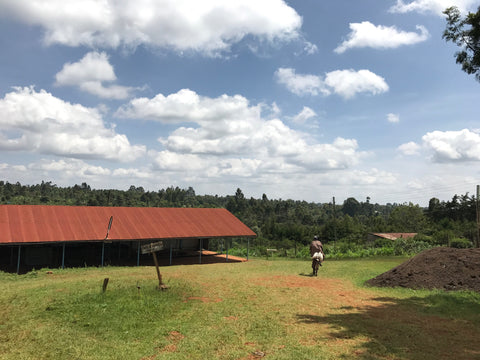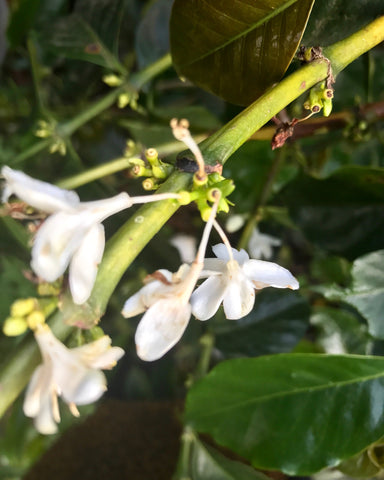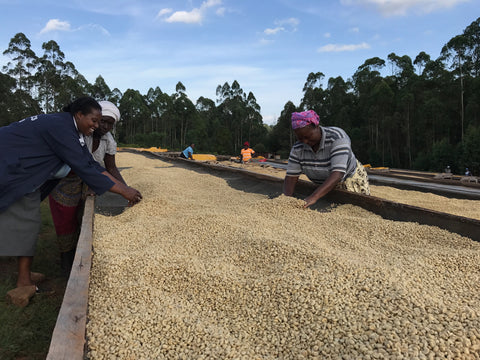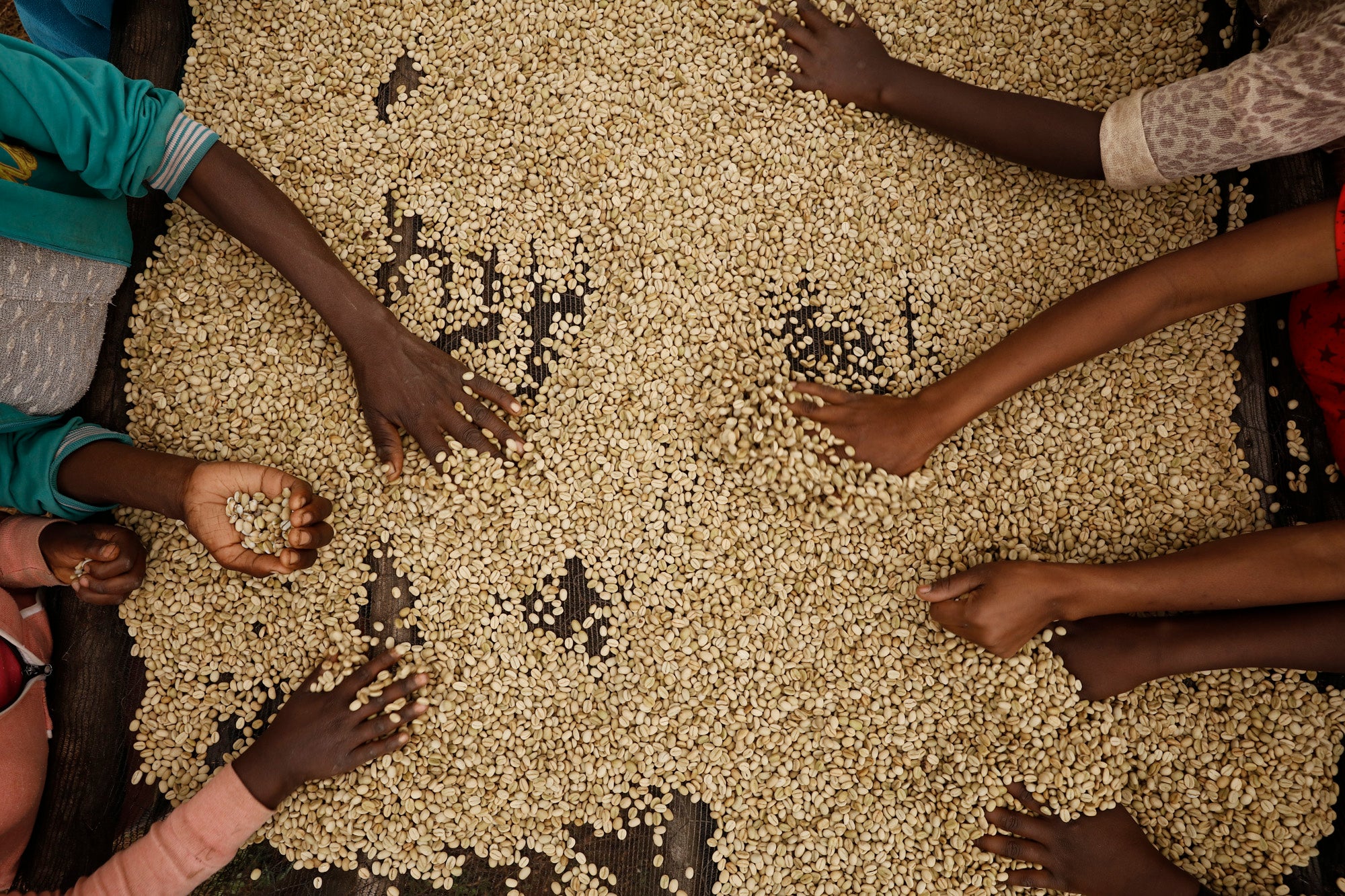General coffee information about Kenya - trading and processing
It's the time of year when we're receiving fresh crop from Kenya. We're buying our Kenyan coffee through Nordic Approach and travel there with them every year during harvest. Every year getting a little better understanding and even more admiration to the country and their coffees. Based on this we wanted to share some general information about trading, varietals and challengers in the country. This post is mainly written for baristas and the once brewing Kenyan coffee at home who wish to know more about Kenya as a coffee producing country.
Drop Coffee and Kenya
Kenya is one of Drop Coffees main origins and somewhere from which we have been buying coffee from ever since the company’s early days due to our love for its unique taste profiles. The character of a great Kenyan coffee has no likeness in other terroirs, particularly when it comes to its most unique attributes, such as crisp clear acidity and the notes of blackcurrants and rhubarb. A coffee from Kenya can act as a great introduction to speciality coffee for those whom have never previously experienced it: a chance to highlight the potential of truly great coffee.
Although there is lots of great coffee to be found in Kenya, this is the fourth year a majority of our Kenyan coffee is coming from just Kamwangi. This is for two reasons, but first and foremost, it is because the taste of the coffee delivers “delicious” every year. The other reason is the transparency of the production we get through our green coffee buyer Nordic Approach—buying coffee with a transparent chain is incredibly tricky, as you’ll learn in our quick primer on coffee in Kenya below.
Coffee Production in Kenya
In Kenya about 150,000 hectares of arable land is planted with coffee. Although coffee has lately benefited from an increase in global prices, this doesn't mirror the volumes produced – output has contracted from a high of about 130,000 metric tons in 1989 to 50,000 tons in 2012. Still, coffee exports counts for about 10% of Kenya’s income.
In the 1950, several extremely successful hybrids from Scott Laboratories were introduced and these have largely replaced the original varietal stock which had been brought to Kenya from neighbouring Ethiopia.
In 1934, the colonial government allowed indigenous people to plant coffees under strict regulations. After 1950, the smallholder sector picked up and they started to build wet mills from the 1960s. In 1978, the smallholder sector surpassed the large estates in terms of production – this is still true today.
Although Kenyan coffee is known for its very unique flavour characteristics, Kenya itself consumes only about 70g of coffee per person a year (2015). This is about 7% of the countries production compared to the neighbouring country Ethiopia, who consume 50% of their own production – and this is also a factor in that they produce more than Kenya. The coffee drinking culture in Ethiopia is of course heavily impacted by coffee growing wild in Ethiopia. Its also an important to remember that coffee was brought into Kenya during a colonized period. They also have a very strong tea culture and tea production.
Main Varieties in Kenya
Today the two well known varietals from Kenya, SL28 and SL34, they are Bourbon hybrids – it is these which give Kenya the distinctive winey blackcurrant notes as mentioned above. Back in the 30’s, the new varietals from the Scot Laboratories were prefixed as SL. The SL28 and SL34 are both productive when healthy, but least resistant and prone to attack and cold.
There is also a newer Kenyan varietal K7 that has a strong immunity towards diseases, but is not appreciated as much for its cup quality as the SLs. Ruiru11 is a higher yield plant, resistant to leaf rust and CBD (see ”challanges”) . It’s a mix of “Hibrido de Timor” (a Robusta/Arabica hybrid) with “Rume Sudan” from the Boma plateau as well as with SL 28 and SL 34 for improved flavour.
Batian is a new high yielding disease resistant variety that was released by the Coffee Research Foundation in Kenya in 2010. It is known for being more equal to the SL in flavour. It’s back crossed from SL 28 and SL 34 and include SL4, N39, N30, Hibrido de Timor, Rume Sudan, and K7 .However the cherries are small, which can affect the farmers income when higher quality (and therefore price) is associated with a larger screen size. See a few example on our instagram account during our last Kenya visit.
Following independence from the British in 1963, Kenya organised their coffee industry around a weekly government-run open from the already established auction system. This transparent system is establishing a pricing hierarchy based on quality with finer lots fetching higher prices. There is now increasing competition for the better-known estates and co-ops and particularly for the AA grade beans. The grades of the beans are simply a measure of bean size where AA is screen 17/18; AB is screen 15/16 with a tolerance for 10% below screen 15. The screen size system is a hang over from commodity market times. Although larger screen sizes normally attract higher prices, it is no indication of the quality of cup, and often just means a slightly different taste profile, not necessarily a better one. This year we have the AA version of the Kamwangi, we’re also having the AB from Kamwangi (and truly encourage you to try them both).
General Trading system in Kenya
The aforementioned system is complicated but here is a somewhat simplified explanation of how coffee production and sales work for coffee cooperatives in Kenya:
Although estate coffee exists in Kenya, over 70% of coffee is produced through cooperative owned factories – and this is where you will generally find very high end Kenyan coffees. Estates have been in demise because of the high demand for housing in Kenya, and land owners selling there farms for gated communities.
There are about 700,000 small holders farms in Kenya, each of whom has on average 0.4 hectare of land. Each smallholder can choose where to deliver their cherry for milling and processing, creating a free market with each farmer. Producers generally choose to deliver to more than one factory. This can be because of locality, payment records, days of accepting deliveries and quality of coffee they have on a particular day.

Cherries delivery to a factory by bike from surrounding farmers.
The size of factory can rage from a few hundran to many thousands with some of the largest. Each farmer owning a small plot of tress normally adjacent to their homes. Once a farmer has delivered cherry to a factory of their choosing, they are credited with a receipt stating how much was delivered on that particular day and the cumulative total for the season. The coffee is then combined with other deliveries from the same date for processing. From this point on, and until a final sale is made to a buyer (in our case, the importer Nordic Approach), the coffee belongs to the cooperative (New Ngariama Cooperative Society).
Each cooperative chooses from different marketing agents to represent their factories and the farmers. It is the marketing agent’s job to take care of the parchment until it is sold and ensure as high a premium is attained for each lot. The marketing agent sends the parchment for dry milling and decides whether each lot should be sent to auction or sold directly. As contracts with marketing agents are limited to one year by law there is a lot of fluctuation, with cooperatives often choosing to switch marketing agents from year to year based on the previous year’s coffee prices.
This system ensures a fair and open market but can also make things difficult for coffees buyers, such as ourselves, who aim to build up long term relationships with producers. When contracts are short-term it becomes difficult for marketing agents to invest in improvements to processing and education as the cooperatives that they are working with may just as well switch to a different agent the following year, meaning that they may never see the benefit of their investment. This also encourages marketing agents to send coffee to the central auction in Nairobi instead of selling directly to overseas buyers as if the price dips from previous years it will be seen as a fluctuation of the market and not the fault of the marketing agent themselves. This is how 90% of all Kenya coffee is sold: it’s positive for transparency as each lot will receive a fair price based on quality. Kenya’s coffee auction system dates back to September 1935. The auctions still take place at the Nairobi Coffee Exchange and have previously been considered to be most transparent distribution system for fine green coffees anywhere in the coffee world and inspired the model for the Cup of Excellence auctions.
Last year, the Kamwangi coffee that we are buying, were able to pay their farmers 75 Kenyan Shillings per kilo of delivered coffee cherries, which is on the higher side of premiums we found whilst traveling. Although it's our and the cooperatives aim to raise this price in the future.
There are several ways this amount can rise: firstly by rising the overall quality of production of the coffee. This means that a higher price can be reached at auction (the farmer’s share will also increase). This years the prices on the market was super high, some of the highest prices AA’s landed over $15.00/kg at the auction. This is not taking into account post processing costs such as: Grainpro or vacuum packing, PSS sample drawing, loading containers for shipment, the actual shipment costs and clearance upon arrivals to a importer. Another way to increase prices is to increase the volume produced. Volumes can also be increased by achieving higher yields per tree. This can be done by educating farmers in agricultural practices helping them with financing fertilizer, training and of course finding an international market for the coffee through a proactive marketing agent.
Normally the cooperatives gives a small advance payment to the farmers at delivery. The factory does have some costs it has to cover. But some well managed wet mills are able to give more than 85% of the sales price back to the farmers. At Kamwangi they were able to give back 80% last year after cost of milling and marketing is deducted, and are aiming to improve this in coming years. This is a tight balance between investing in machinery and equipment for the factory to raise quality (and prices) and making sure farmers who deliver to the factory get as much of the money paid as possible.
Challenges for coffee production in Kenya
Climange change is impacting the harvest of coffee. We remember visiting Kenya only five years back to see that the top of Mount Kenya was covered in snow. Visiting at the same time of the year, December, during this years’ harvest, we could barely see any snow on the mountain. There ahave always been changes in climate in coffee producing countries and it is difficult to calculate the effects of the short term climate changes on production. But it is obvious that there are changes happening in the country and it is effecting harvests and yields.
Its also hard for farmers who have always known when it’s going to rain or not, which makes coffee farming more challenging. Particularly when there is not the investment in agronomy and education in coffee husbandry.
Another clear sign of climate change can be seen during the second crop (also under the name ”fly crop”, a tiny harvest in August). There was lots more flowering which in turn means a higher yield on the potential "fly crop".

Flowering already started for the fly crop that seems to be slight bigger in volume year by year
Last year (2015-2016), the coffee production was heavily impacted by the El Niño weather conditions, but the expectation was still high compared to the last five years. The strange weather patterns after El Niño created unusually warm water in the Pacific that caused highly unusual heavy rainfall in Kenya – this unseasonal weather delayed the flowering process for the coffee plants and made the production harder to control. It interrupted the cherry maturation process as well as the drying process. As a result of these conditions, Kenyan coffee production has decreased in some cases as much as 50% and in others a just 20%. But what we did see was everyone reported some loss in yield this year, which means less money for the cooperatives.
As mentioned above, the two most common varietals, SL28 and SL34, are not resistant to leaf rust - a fungus attacking the plant’s ability to photosynthesize (and thus grow and mature cherries). Leaf rust can be controlled with copper-based fungicides spray. It has become more important for farmers to be proactive in making sure they are not attacked by this fungus.
“Coffee berry disease” (often under the name CBD, reda more at http://www.extento.hawaii.edu/kbase/crop/Type/c_coffe.htm) caused by the virulent strain. The fungus lives in the bark of the coffee tree and produces spores which attack the coffee cherries. When attacked it makes the cherry almost black in colour and can be devastating for the whole farm.
Spraying has been determined to be the best way to avoid the coffee berry disease. It can be treated with copper formulations or organic fungicides. Still, this is often too expensive for many farmers. The hybrid Ruiru 11 is planted in smaller amounts on most farms delivering to Kamwangi and generally in Kenya due to its cup profile. But the varietal is more resistant to both coffee berry disease and coffee leaf rust.
With all of the challenges facing Kenya we remain very excited to share these delicious coffees with you, and still holds a very special place in our hearts.
Processing
Part of what makes the Kenyan taste profile so unique is achieved through the highly controlled way in which it is processed and sorted. Rigorous sorting is done at each stage of the processing and the dry milling, creating an extremely consistent final product. Heres a very general explanation on how coffee is being processing on most factories we've visited.

Coffee cherries is being delivered from surrounding farmers and cooperative members.

Sorting cherries from defects, over- and underripe cherries before the coffee is going into production.
Once the cherries are delivered to the factory and have been sorted for over and under ripe cherries, they are generally de-pulped directly by a large 3 or 4-disced pulper, which removes the cherry from the coffee bean. The coffee is from here on known as parchment.
This pulper also acts as the next stage of sorting, as the low density beans float to the top of water channels after the pulp is removed and are washed down into a separate fermentation tank to the denser, higher quality beans. Once it been de-pulped, the coffee parchment is fermented in large concrete tanks overnight, breaking down the sugar layer (mucilage) so that it may easily be removed during the washing process. Fermentation can take 12-16 hours depending on the temperature.
The farm manager checks when the coffee has finished fermented by rubbing the parchment between her hands: if there is abrasion, then the mucilage has deteriorated sufficiently and the coffee may be washed further along the line to the washing channels. If the parchment is allowed to ferment further, its delicate flavour characteristics would be ruined so washing must occur at a very particular time in order to stop the fermentation process.
The parchment is washed in fresh water in order to remove the residual sugars from the mucilage and is here further sorted by density. Lower density beans are once again separated to be sold as lower grade coffee whilst the higher density parchment is held back by gates in the channels whilst workers sweep along the channels with paddles in order to move the coffee.
Beans being graded after density in wash channels.
Once the washing process is complete, the coffee is moved to drying beds in order to lower the moisture content to a stable level before storage. On the drying tables the coffee is sorted and stirred by hand in order to ensure an even drying, until the moisture content reaches 11-13% when is it moved to conditions bins for storage where it normally sinks about 2% or more.

Many hours of rotating, sorting and drying the coffee.
Sources:
http://www.extento.hawaii.edu/kbase/crop/Type/c_coffe.htm
http://www.nordicapproach.no/origins/kenya/
http://www.foodbusinessafrica.com/index.php/magazine/company-features-industry-reports/509-the-coffee-industry-in-kenya
http://www.foodbusinessafrica.com/index.php/magazine/company-features-industry-reports/509-the-coffee-industry-in-kenya
Learn More
- Choosing a selection results in a full page refresh.
- Press the space key then arrow keys to make a selection.

